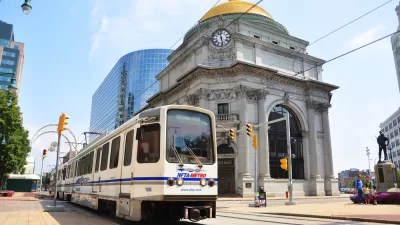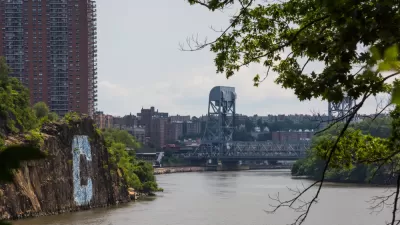A plan to revitalize Buffalo's Outer Harbor as an expansive, fully programmed park was sunk by a housing component. A new draft is expected soon.
Mark Sommer reports on the process of planning a new future for Buffalo's Outer Harbor. A previous planning process for the "526 acres of nature on a windy Lake Erie" culminated in September 2014 as a vision of pedestrian and bike paths, hiking trails, shoreline enhancements, boat launches, a gazebo, a playground, overlooks, and amphitheater, and a waterfront promenade, among other amenities and facilities.
But, Sommer reports, "adding housing and cultural development – the icing on the cake to some waterfront planners – proved to be a flash point. Opposition from the public and key lawmakers forced the plan back to the drawing board."
The proposal called for three clusters of housing, totaling between 1,500 and 2,100 units, which would help pay for the park that would make up most of the area. "But the idea of dense housing on the Outer Harbor scored poorly with the hundreds of people who participated in planning exercises," reports Sommer. "That included opposition to housing planned on land east of Times Beach, from where the Queen City Bike Ferry now arrives and departs, and Wilkeson Pointe. The waterfront agency said a study showed the preserve wouldn’t be harmed. Environmentalists disagreed."
The rest of the article goes on to examine other models that might influence the next draft of the plan, including the improvements made at the Milwaukee waterfront as well as standards set by the Green Code, expected for adoption by the Buffalo Common Council later this year.
FULL STORY: Outer Harbor popularity places spotlight on housing

Study: Maui’s Plan to Convert Vacation Rentals to Long-Term Housing Could Cause Nearly $1 Billion Economic Loss
The plan would reduce visitor accommodation by 25,% resulting in 1,900 jobs lost.

North Texas Transit Leaders Tout Benefits of TOD for Growing Region
At a summit focused on transit-oriented development, policymakers discussed how North Texas’ expanded light rail system can serve as a tool for economic growth.

Using Old Oil and Gas Wells for Green Energy Storage
Penn State researchers have found that repurposing abandoned oil and gas wells for geothermal-assisted compressed-air energy storage can boost efficiency, reduce environmental risks, and support clean energy and job transitions.

Private Donations Propel Early Restoration of Palisades Playground
Los Angeles has secured over $1.3 million in private funding to restore the Pacific Palisades playground months ahead of schedule, creating a modern, accessible space that supports community healing after recent wildfires.

From Blight to Benefit: Early Results From California’s Equitable Cleanup Program
The Equitable Community Revitalization Grant (ECRG) program is reshaping brownfield redevelopment by prioritizing projects in low-income and environmental justice communities, emphasizing equity, transparency, and community benefits.

Planting Relief: Tackling Las Vegas Heat One Tree at a Time
Nevada Plants, a Las Vegas-based nonprofit, is combating the city’s extreme urban heat by giving away trees to residents in underserved neighborhoods, promoting shade, sustainability, and community health.
Urban Design for Planners 1: Software Tools
This six-course series explores essential urban design concepts using open source software and equips planners with the tools they need to participate fully in the urban design process.
Planning for Universal Design
Learn the tools for implementing Universal Design in planning regulations.
Ascent Environmental
Borough of Carlisle
Institute for Housing and Urban Development Studies (IHS)
City of Grandview
Harvard GSD Executive Education
Toledo-Lucas County Plan Commissions
Salt Lake City
NYU Wagner Graduate School of Public Service




























